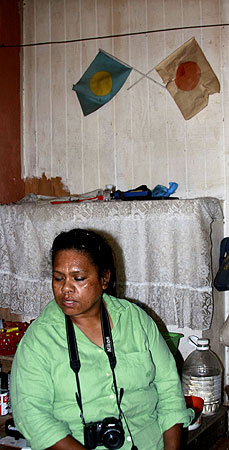| P-MAN XV Update #19 - More interviews 9 April Today we spent traveling within the states of Aimeliik and Airai, conducting interviews with elders. In the morning, Sylvia from the Bureau of Arts and Culture took us around and in the afternoon, we were joined by an Airai State official, Remie, to take us within her state. As I said, things have changed since we first began doing round-robin interviews on the big island.
We did get some new information about sites we already know about. And we did get some information stating that where we are looking on the big island is not where any executions took place. The location is different than the trail Mark Swank deduced from looking at all the War Crime Tribunal records, but the geometry of it could work out if some of the distances were stretched. Once we get a bit more data, we're going to give Mark a compilation of the new data on a map, and let him see if he can make this work along with his other data. One thing we will do in our next interview session is go to a village in Ngatpang and ask for the specific location of an area one of the elders named. Every section of the forest has a name here in Palau. The elder in Airai knew the name, but could not remember the specific geographic area. He suggested going to this village and asking someone there. He's sure of the name of the area, as he had friends during the war tell him, he's just not sure the exact physical location: this valley, or the next one over. After the interviews were over, BentProp, sans escorts, went up to this new area. It's big. We are definitely going to have to narrow it down. In a few days we'll return and see what info we can develop. Not much else happened today. It feels like it's getting to be the end of the mission. New stuff comes in without sufficient time to fully prosecute it. I guess that's job security for next year. But we still have a few more days to go this year. The next two days will be on the water. 10 April We took our five top side scanning sonar hits, loaded our SCUBA gear, pulled out our best underwater search patterns and came up with nothing. It was great fun to run search patterns with five of us in a line, not being able to see past one individual in the line. Compass heading, flipper flips, safety stops in mid ocean. You can't buy training like this. I think Casey is getting his advanced diver qual without cracking a book! The highlight of the day, (okay, for Pat, Dan and me, but not necessarily Casey), was movie night. Dan downloaded an old sci-fi classic, Forbidden Planet. It was great.
Tomorrow is the last day on the water (or rather UNDER the water for Flip and Casey. We will do interviews on the 12th, and on the 13th we can't dive because we fly out late that night (and must allow at least 24 hours before flying to rid our bodies of residual nitrogen). Dan and Pat could dive on the 13th, but this may be their last SCUBA adventure of the trip as well. The trip is definitely coming to a close. An interesting question came up from the fan base. Why did we work so much to identify the Shiun, when from the first dive it was obviously Japanese, regardless of what specific airplane it was? Great question! From the first dive, we always suspected that there COULD be MIAs associated with this site. The front cockpit's sliding canopy was not open enough for someone to crawl out. Since the Japanese government, and other Japanese NGOs, has shown more interest lately in repatriating their servicemen who did not come home, we thought we should do what we could to help in that effort. We don't do actual recoveries. We do investigative work. So we investigated. Without knowing more about this airplane, we could not figure out the context of this crash site. A true collaborative effort took place here, and will continue until the full story is known: Scripps Institution found it, we started characterizing it and identifying it, and some organizations that specialize in Japanese history are helping to place this particular aircraft into a historical context:
The research is ongoing. There are some differences in the historical narratives. After we get home and can read at our leisure, we'll have a much better idea of what happened that day out here. - Flip Colmer |

- Main Site
- Expeditions
- Our Story
- Miscellany










